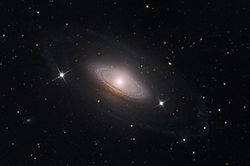| NGC 4698 | |
|---|---|
 NGC 4698 imaged with the 32-inch Schulman Telescope at Mount Lemmon Observatory | |
| Observation data (J2000 epoch) | |
| Constellation | Virgo |
| Right ascension | 12h 34m 20.310s [1] |
| Declination | +08° 11′ 51.94″ [1] |
| Heliocentric radial velocity | 1,002 [2] km/s |
| Distance | 54.8 Mly (16.8 Mpc) [3] |
| Group or cluster | Virgo Cluster |
| Apparent magnitude (V) | 10.6 [4] |
| Apparent magnitude (B) | 11.46 [5] |
| Characteristics | |
| Type | SA(s)ab [3] |
| Apparent size (V) | 4′.0 × 2′.9 [4] |
| Notable features | Seyfert-2 galaxy [6] |
| Other designations | |
| PGC 43254, UGC 7970, VCC 2070 | |
NGC 4698 is a barred spiral galaxy [5] located around 55 [3] million light years away from Earth in the constellation of Virgo. It belongs to the Virgo Cluster of galaxies and is positioned near the northeastern edge of this assemblage. [4] The morphological classification of NGC 4698 in the De Vaucouleurs system is SA(s)ab, [3] which indicates a purely spiral structure with moderate to tightly wound arms. [7] It is inclined to the line of sight from the Earth by an angle of 53° along a position angle of 170°. [8]
Contents
A unique feature of this galaxy is that the stars and dust of the nuclear disk are rotating in a direction that is aligned perpendicularly to the galactic disk. The bulge likewise appears elongated out of the galactic plane. This unusual alignment may have been the result of a past merger event. [5]
NGC 4698 is classified as a Seyfert-2 galaxy with an active galactic nucleus, which displays a prominent emission of radio and X-ray energy from the core while showing narrow emission lines in the optical spectrum. [6] The unified model of Seyfert galaxies proposes that the nucleus of a Seyfert 2 galaxy is obscured by a thick torus of gas and dust. However, the varying X-ray emission of the core of NGC 4698 shows little indication of being obstructed, suggesting instead that the source of the energy emission is generally unobscured but anemic in nature. [9]


